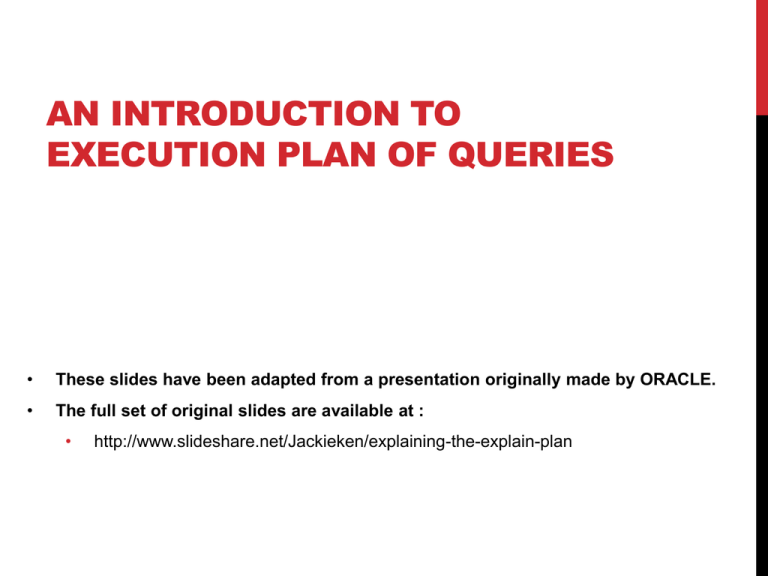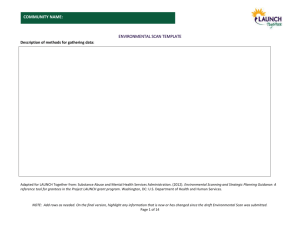Introduction to Explain plan in Oracle
advertisement

AN INTRODUCTION TO
EXECUTION PLAN OF QUERIES
•
These slides have been adapted from a presentation originally made by ORACLE.
•
The full set of original slides are available at :
•
http://www.slideshare.net/Jackieken/explaining-the-explain-plan
WHAT IS AN EXECUTION PLAN?
• Detailed steps necessary to execute a SQL statement
• Steps expressed as
•
a set of database operators that consumes and produces rows
• Optimizer decides
•
•
The order of the operators and their implementation
using query transformations and physical optimization techniques
• The display is commonly shown in a tabular format,
•
but a plan is in fact tree-shaped
TABULAR AND TREE REPRESENTATIONS
Query
SELECT prod_category,
avg(amount_sold)
FROM sales s, products p
WHERE p.prod_id = s.prod_id
GROUP BY prod_category;
Tree-shaped representation of plan
Tabular representation of plan
----------------------------------------------------------Id Operation
Name
----------------------------------------------------------0 SELECT STATEMENT
1 HASH GROUP BY
2 HASH JOIN
3 TABLE ACCESS FULL
PRODUCTS
4 PARTITION RANGE ALL
5
TABLE ACCESS FULL SALES
----------------------------------------------------------
GROUP BY
|
JOIN
______|_______
|
|
TABLE ACCESS
TABLE ACCESS
PRODUCTS
SALES
HOW TO GET AN EXECUTION PLAN ?
EXPLAIN PLAN command
• Displays an execution plan for a SQL statement without actually
executing the statement
• EXPLAIN PLAN SET STATEMENT_ID = '<some-name>' FOR
<select statement to be analyzed>;
• Plan stored in PLAN_TABLE
QUERY THE PLAN_TABLE
SELECT LPAD(' ', 2*LEVEL)||OPERATION||' '||OPTIONS||' '||OBJECT_NAME
Query_Plan
FROM PLAN_TABLE
CONNECT BY PRIOR ID = PARENT_ID
and STATEMENT_ID = '<some-name>'
START WITH ID=0 and STATEMENT_ID = '<some-name>'
ORDER BY ID;
USE CASE
Use Case: Plan review allows review of access paths and join types
Access paths
• Is the data being accessed in the best way? Scan? Index lookup?
Join type
• Are the right join algorithm types being used?
ACCESS PATHS
Access Path describes method to get data out of the table
The access path can be:
•
•
•
•
•
•
•
•
•
Full table scan
Table access by Rowid
Index unique scan
Index range scan (descending)
Index skip scan
Full index scan
Fast full index scan
Index joins
Bitmap indexes
EXAMPLE OF ACCESS PATHS
What access method should be use for this Query?
SELECT e.name, e.salary, d.dept_name
FROM hr.employees e, hr.departments d
WHERE d.dept_name IN ('Marketing‘,'Sales')
AND e.department_id=d.department_id;
Employees has 107 rows
Departments has 27 rows
Foreign key relationship between Employees and Departments on dept_id
Look in Operation session to see
how obj is being accessed
JOIN ALGORITHM TYPE
A Join retrieve data from more than one table
Possible join algorithm types are
•
•
•
•
•
•
Nested Loops joins
Hash Joins
Partition Wise Joins
Sort Merge joins
Cartesian Joins
Outer Joins
JOIN ALGORITHM TYPE EXAMPLE
What Join type should be use for this Query?
SELECT e.name, e.salary, d.dept_name
FROM hr.employees e, hr.departments d
WHERE d.dept_name IN ('Marketing‘,'Sales')
AND e.department_id=d.department_id;
Employees has 107 rows
Departments has 27 rows
Foreign key relationship between Employees and Departments on dept_id
Look in Operation session to
see Join strategy







